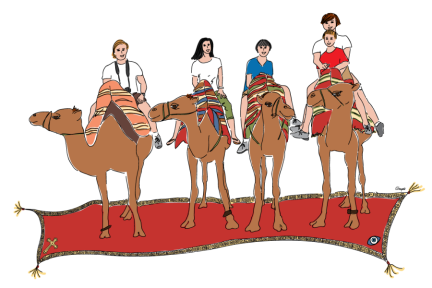On the top of our list of our Havana itinerary, was the spellbinding FAC: Fabrica de Arte Cubano.  The once-derelict factory is now the famous, cosmopolitan art gallery. Having been on several satisfying art crawls in the states, I have never quite experienced an art gallery like this one. Art has the power to transform and this is definitely happening in Cuban art. FAC housed so many superior art forms within its rustic architecture. Tierra, a restaurant within a shipping container, was in one area of the building. Outside of Tierra, a movie screen played a movie while people gathered in small groups enjoying beverages. Art displayed outside was framed by a magical and celestial rainbow. The colors of the sky were saturated at this dusk time after an earlier light rainfall.
The once-derelict factory is now the famous, cosmopolitan art gallery. Having been on several satisfying art crawls in the states, I have never quite experienced an art gallery like this one. Art has the power to transform and this is definitely happening in Cuban art. FAC housed so many superior art forms within its rustic architecture. Tierra, a restaurant within a shipping container, was in one area of the building. Outside of Tierra, a movie screen played a movie while people gathered in small groups enjoying beverages. Art displayed outside was framed by a magical and celestial rainbow. The colors of the sky were saturated at this dusk time after an earlier light rainfall.

Looking into the enormous doorway of FAC, there was a darkly lit dance floor where modern dancers were stretching, turning and flipping. One minute, we were watching dancers strut across a dance floor/stage and another minute we were gazing at the massive and colorfully lit bar where a famous artist was identified.


There were deejays, a bar with alcohol bottles overhead on a conveyor belt suspended from the ceiling, and floors of provocative art; celebrating nudity and diversity.

 The line to get into FAC was extremely long but we were able to bypass the line since we had pre-purchased tickets. My friends and I observed some of the art together and then we separated to enjoy it, individually. It was a very cosmopolitan evening of culture, diversity, art and relaxed glamour. It surpassed what I expected and what I had seen on TV about this Havana treasure. Historically, the art scene in Cuba has been inspiring for a long time. It is said that Cuba has been a playground for the inspired eccentricities of various artists and authors, whether it’s Hemingway, Jose Marti, Jose Fuster, etc. I also admire the artwork of Salvador Gonzales Escalona with his surrealism, Afro-Cuban style, cubism and abstract art.
The line to get into FAC was extremely long but we were able to bypass the line since we had pre-purchased tickets. My friends and I observed some of the art together and then we separated to enjoy it, individually. It was a very cosmopolitan evening of culture, diversity, art and relaxed glamour. It surpassed what I expected and what I had seen on TV about this Havana treasure. Historically, the art scene in Cuba has been inspiring for a long time. It is said that Cuba has been a playground for the inspired eccentricities of various artists and authors, whether it’s Hemingway, Jose Marti, Jose Fuster, etc. I also admire the artwork of Salvador Gonzales Escalona with his surrealism, Afro-Cuban style, cubism and abstract art.
Throughout our trip, we continued to interpret the art that provoked us and inspired us. The use of mediums (like photography and painting fused onto the same canvas) were powerful. The social messages were intense and the blending of contemporary art within an old, rustic building was ironic and delicate.
In Havana’s outskirts, in the Jaimanitas fishing town, we visited a neighborhood transformed by Jose Fuster’s artwork.
When we entered the neighborhood, we noticed the entrance sign in Spanish saying that it was in Homage to Gaudi. Reportedly, Fuster designed one house in the mosaic-encrusted tiling and others became so interested in having their homes decorated the same way. Eventually, eighty homes were decorated in the same vibrant, eclectic and whimsical way. This public artwork of ornate murals took over ten years. It is said to have been done to suit the personality of Fuster’s neighbors.

The home with an entrance titled “Princesa Diana” intrigued me. Just as we tried to absorb the details and whimsy, we were distracted by all the other intricate details and compliments to the neighborhood…..like the florals, trees and horse-drawn carriages prancing by.

Jose Fuster’s artwork has been compared to that of Barcelona’s Gaudi. This connection to Cuba’s Spanish heritage is one of the features that makes Cuba so fascinating to visit. Cuba’s Afro-Latino backgrounds break down more specifically into Spaniard and Nigerian influences due to the colonists who settled the area and the Africans they brought over.
I’ve never observed a neighborhood as an actual piece of art quite like this one. While all architecture “tells a story” in some way, this whimsical display conveyed layers of stories to me. I found Havana’s art to be a vehicle for the people’s self-expression. Art is an outlet which is therapeutic and in this case (with the neighborhood), it served a constructive purpose.
photos by Gina Kingsley


